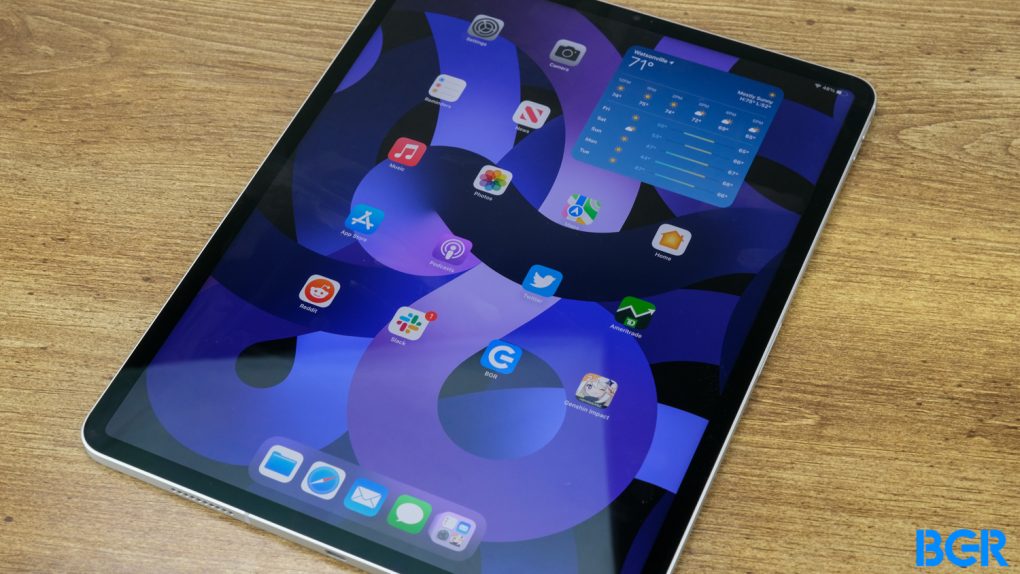Apple is widely expected to unveil the 2024 iPad Pro soon. The M3 chip won’t be the only upgrade for the next-gen tablets. Both models are expected to get OLED screens as well, which will replace the mini-LED and LCD screens the current generation uses.
Over the years, we’ve seen plenty of reports detailing the new OLED screens that Apple wants from its suppliers. We kept hearing about two-stack tandem structures for these OLED panels. Most recently, a report said that LG is working on such iPad Pro displays for Apple. Samsung is another obvious candidate to supply these displays, though older reports said Samsung first resisted Apple’s iPad Pro screen design requirements.
Two-stack OLED screens offer improved brightness as they have two light-emitting layers. They’re also more efficient than single-stack design and might offer enhanced longevity. Finally, reports say these OLED panels will be thinner than before, which would impact the overall size of the iPad.
Fast-forward to CES 2024, and I can’t help but wonder whether Samsung has quietly announced the OLED panel tech it’ll use for the iPad Pros.
Samsung’s new UT OLED panels
Samsung announced its newest display innovations ahead of CES, and we’ve already covered the In&Out Flip foldable screen that folds both ways. That was just one of the new screens Samsung unveiled.
The company also announced the ultra-thin (UT) panels. Here’s how Samsung describes them:
One notable feature is the ultra-thin (UT) panel. Samsung Display’s UT OLED panels are about 0.6mm thick, similar to the thickness of a business card, which is one-third the thickness of an LCD panel. This difference is easily noticeable even to the naked eye. Additionally, the UT OLED panels are lightweight, with three UT OLED panels weighing the same as one LCD panel of the same size.
Samsung said that “by applying a new module process, we have reduced the thickness while maintaining the same strength. We are confident that this will help laptop and tablet manufacturers increase portability and differentiate their designs.”

The company also detailed another upgrade for the UT panels, which will reduce power consumption:
Thin-film transistors (TFTs), which regulate current flow, now utilize 100% oxide instead of amorphous silicon (a-Si). This change allows for faster electron movement (about 10 times faster than with a-Si) and reduces current leakage. As a result, flickering, which occurs when a display is driven at a low refresh rate, can be eliminated. Samsung Display’s latest products are the first IT panels to support variable refresh rates as low as 1Hz, enabling significant power savings.
Samsung also provided the image above, which shows how thin UT OLED panels are compared to an LCD screen.
But wait, there’s more…
What’s lacking from Samsung’s press release is the two-stack design for the panel. Everything else seems to fit the iPad Pro OLED display upgrade narrative. Maybe the UT OLED screen Samsung unveiled at CES isn’t a two-stack one. Or maybe Samsung doesn’t mention that detail to avoid connections with the iPad Pro OLED rumors.
Whatever the case, this UT OLED screen sounds like the kind of display Samsung would want to sell to Apple and other tablet vendors.
Separately, a Korean leaker just revealed the purported price tags of the 2024 iPad Pros. We’re looking at $1,500 for the 11-inch and $1,800 to $2,000 for the 13-inch model. They also said Apple will market the tablets heavily, focusing on various selling points.
The list includes the brighter OLED screens and the tablets’ overall size. The leaker claims that the next iPad Pros will be the thinnest and lightest tablets made to date.
For such a feat, you’d need displays like the UT panel that Samsung just unveils. I am just speculating, of course. We’ll have to wait for Apple to unveil the iPad Pro to see what kind of OLED panels the new tablets employ.








